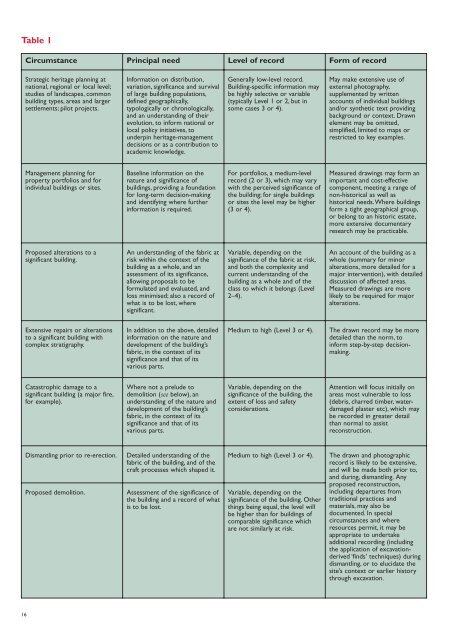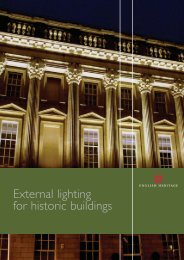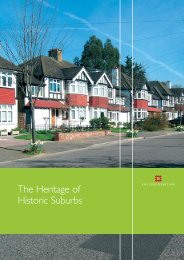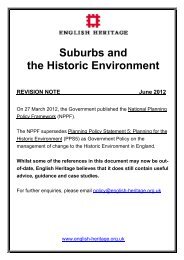Understanding Historic Buildings - HELM
Understanding Historic Buildings - HELM
Understanding Historic Buildings - HELM
You also want an ePaper? Increase the reach of your titles
YUMPU automatically turns print PDFs into web optimized ePapers that Google loves.
Table 1<br />
Circumstance Principal need Level of record Form of record<br />
Strategic heritage planning at<br />
national, regional or local level;<br />
studies of landscapes, common<br />
building types, areas and larger<br />
settlements; pilot projects.<br />
Management planning for<br />
property portfolios and for<br />
individual buildings or sites.<br />
Proposed alterations to a<br />
significant building.<br />
Extensive repairs or alterations<br />
to a significant building with<br />
complex stratigraphy.<br />
Catastrophic damage to a<br />
significant building (a major fire,<br />
for example).<br />
16<br />
Information on distribution,<br />
variation, significance and survival<br />
of large building populations,<br />
defined geographically,<br />
typologically or chronologically,<br />
and an understanding of their<br />
evolution, to inform national or<br />
local policy initiatives, to<br />
underpin heritage-management<br />
decisions or as a contribution to<br />
academic knowledge.<br />
Baseline information on the<br />
nature and significance of<br />
buildings, providing a foundation<br />
for long-term decision-making<br />
and identifying where further<br />
information is required.<br />
An understanding of the fabric at<br />
risk within the context of the<br />
building as a whole, and an<br />
assessment of its significance,<br />
allowing proposals to be<br />
formulated and evaluated, and<br />
loss minimised; also a record of<br />
what is to be lost, where<br />
significant.<br />
In addition to the above, detailed<br />
information on the nature and<br />
development of the building’s<br />
fabric, in the context of its<br />
significance and that of its<br />
various parts.<br />
Where not a prelude to<br />
demolition (see below), an<br />
understanding of the nature and<br />
development of the building’s<br />
fabric, in the context of its<br />
significance and that of its<br />
various parts.<br />
Generally low-level record.<br />
Building-specific information may<br />
be highly selective or variable<br />
(typically Level 1 or 2, but in<br />
some cases 3 or 4).<br />
For portfolios, a medium-level<br />
record (2 or 3), which may vary<br />
with the perceived significance of<br />
the building; for single buildings<br />
or sites the level may be higher<br />
(3 or 4).<br />
Variable, depending on the<br />
significance of the fabric at risk,<br />
and both the complexity and<br />
current understanding of the<br />
building as a whole and of the<br />
class to which it belongs (Level<br />
2–4).<br />
May make extensive use of<br />
external photography,<br />
supplemented by written<br />
accounts of individual buildings<br />
and/or synthetic text providing<br />
background or context. Drawn<br />
element may be omitted,<br />
simplified, limited to maps or<br />
restricted to key examples.<br />
Measured drawings may form an<br />
important and cost-effective<br />
component, meeting a range of<br />
non-historical as well as<br />
historical needs.Where buildings<br />
form a tight geographical group,<br />
or belong to an historic estate,<br />
more extensive documentary<br />
research may be practicable.<br />
An account of the building as a<br />
whole (summary for minor<br />
alterations, more detailed for a<br />
major intervention), with detailed<br />
discussion of affected areas.<br />
Measured drawings are more<br />
likely to be required for major<br />
alterations.<br />
Medium to high (Level 3 or 4). The drawn record may be more<br />
detailed than the norm, to<br />
inform step-by-step decisionmaking.<br />
Variable, depending on the<br />
significance of the building, the<br />
extent of loss and safety<br />
considerations.<br />
Attention will focus initially on<br />
areas most vulnerable to loss<br />
(debris, charred timber, water-<br />
damaged plaster etc), which may<br />
be recorded in greater detail<br />
than normal to assist<br />
reconstruction.<br />
Dismantling prior to re-erection. Detailed understanding of the Medium to high (Level 3 or 4). The drawn and photographic<br />
fabric of the building, and of the<br />
craft processes which shaped it.<br />
Proposed demolition. Assessment of the significance of<br />
the building and a record of what<br />
is to be lost.<br />
Variable, depending on the<br />
significance of the building. Other<br />
things being equal, the level will<br />
be higher than for buildings of<br />
comparable significance which<br />
are not similarly at risk.<br />
record is likely to be extensive,<br />
and will be made both prior to,<br />
and during, dismantling. Any<br />
proposed reconstruction,<br />
including departures from<br />
traditional practices and<br />
materials, may also be<br />
documented. In special<br />
circumstances and where<br />
resources permit, it may be<br />
appropriate to undertake<br />
additional recording (including<br />
the application of excavationderived<br />
‘finds’ techniques) during<br />
dismantling, or to elucidate the<br />
site’s context or earlier history<br />
through excavation.










